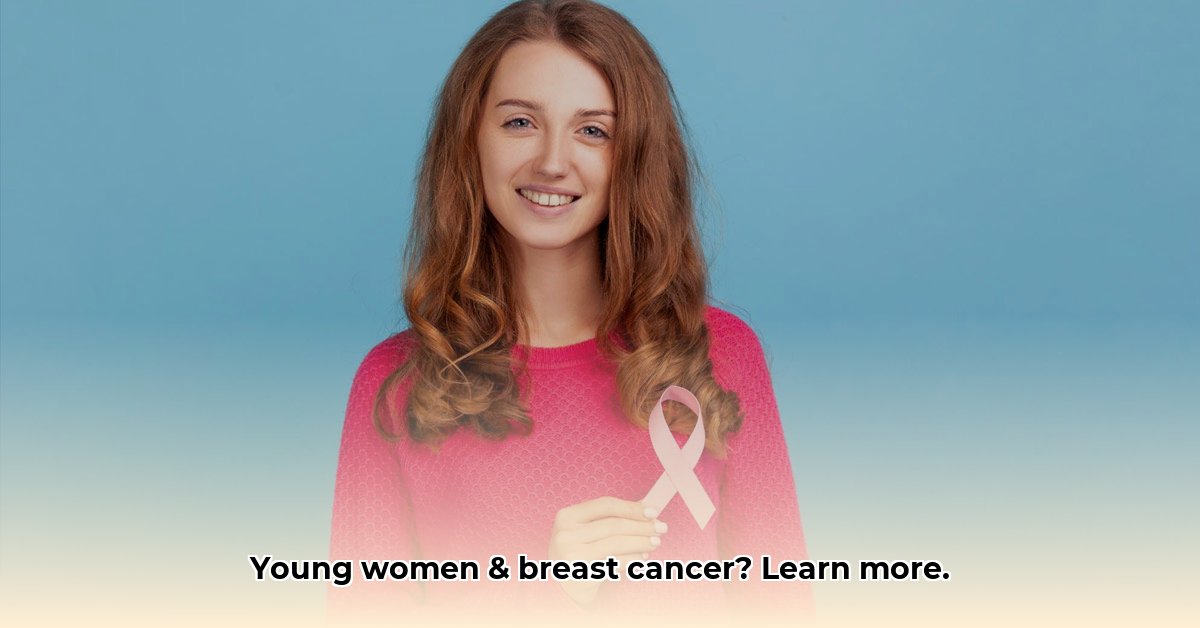A breast cancer diagnosis can be overwhelming, especially for young women. This guide provides comprehensive information about breast cancer in women in their 20s, 30s, and 40s, covering symptoms, diagnosis, treatment, and the unique challenges faced by younger women.
Risk Factors: Understanding Your Potential Risks
Several factors may increase the likelihood of developing breast cancer at a younger age. Some are inherited, while others are lifestyle-related.
Inherited Risks
- Genetics: Inherited gene mutations, such as BRCA1 and BRCA2, can significantly increase breast cancer risk. Other genes like TP53 also play a role.
- Family History: A family history of breast or ovarian cancer, especially in close relatives diagnosed before 50, elevates risk.
- Reproductive Factors: Starting periods early (before 12) or experiencing late menopause (after 55) prolongs estrogen exposure, potentially increasing risk.
- Dense Breast Tissue: Dense breast tissue makes mammograms harder to read and is independently linked to a higher risk.
- Ashkenazi Jewish Heritage: Women of this heritage have a higher likelihood of carrying BRCA mutations.
- Personal History: Previous breast cancer or certain benign breast conditions (like atypical hyperplasia) increases the risk of recurrence or a new cancer.
- Radiation Exposure/DES: Prior chest radiation therapy or exposure to diethylstilbestrol (DES) during pregnancy (if you are a daughter of someone who took DES) are also linked to increased risk.
Lifestyle Factors
- Weight: Maintaining a healthy weight, especially post-menopause, may lower risk.
- Hormone Therapy: Combined estrogen and progesterone hormone replacement therapy (HRT), particularly long-term use, can increase risk. Some oral contraceptives may slightly elevate risk as well.
- Reproductive History: Having a first child after 30, not breastfeeding, or never having a full-term pregnancy may slightly increase risk.
- Alcohol Consumption: Limiting alcohol intake is important, as even moderate consumption can elevate risk.
- Lack of Physical Activity: Regular exercise promotes overall health and may reduce breast cancer risk.
Recognizing the Signs: Symptoms in Young Women
While many breast cancer symptoms are similar across age groups, they may be overlooked in younger women, often attributed to hormonal changes. Be vigilant and report any changes to your doctor.
- Lump/Thickening: A new lump or area of thickened tissue that feels distinct from the surrounding breast tissue.
- Size/Shape Change: Noticeable changes in breast size, shape, or symmetry.
- Skin Changes: Dimpling, puckering, redness, scaling, or thickening of the breast skin (sometimes resembling an orange peel).
- Nipple Changes: Inversion (turning inward), discharge (especially bloody or clear), scaling, or crusting.
- Pain: Persistent or unusual breast pain, differing from typical cyclical tenderness.
- Swelling: Swelling in the armpit or collarbone area (indicating swollen lymph nodes).
Diagnosis: Understanding the Process
If you experience concerning symptoms, your doctor will likely recommend the following:
- Clinical Breast Exam: A manual examination of the breasts and underarm area.
- Mammogram: An X-ray of the breasts, though less effective in younger women due to denser breast tissue.
- Ultrasound: Uses sound waves to create images of breast tissue, often used to clarify mammogram findings.
- MRI: Provides highly detailed images, especially helpful for young women with dense breasts.
- Biopsy: A tissue sample is examined under a microscope to confirm a cancer diagnosis.
Treatment Options: A Personalized Approach
Treatment plans are individualized based on cancer type, stage, overall health, and personal preferences. Options include:
- Surgery: Lumpectomy (removes the tumor) or mastectomy (removes the entire breast), sometimes followed by reconstructive surgery.
- Radiation Therapy: Targets remaining cancer cells after lumpectomy.
- Chemotherapy: Uses drugs to kill cancer cells, administered before or after surgery.
- Hormone Therapy: Blocks estrogen’s effects on hormone-receptor-positive cancers.
- Targeted Therapies: Drugs designed to attack specific cancer cell characteristics (e.g., Herceptin for HER2-positive cancers).
- Immunotherapy: Boosts the immune system’s ability to fight cancer cells, a promising area of research.
Fertility Preservation: Chemotherapy can impact fertility. Discuss egg or embryo freezing before starting treatment if you plan to have children.
Facing the Challenges: Support and Resources
A breast cancer diagnosis at a young age presents unique challenges:
- Fertility Concerns: Openly discuss your concerns with your healthcare team and explore fertility preservation options.
- Emotional and Psychological Impact: Seek support from therapists, support groups, and online communities.
- Body Image Concerns: Reconstructive surgery and counseling can help address body image changes.
- Career and Financial Impacts: Discuss options with your employer and explore financial assistance programs.
Empowering Yourself: Taking Control
While a breast cancer diagnosis is life-changing, it doesn’t have to define you. Early detection is key. Practice regular breast self-exams, schedule clinical breast exams, and talk to your doctor about appropriate screening based on your risk factors. Seek support from loved ones, healthcare professionals, and support organizations. Empower yourself with knowledge and advocate for your needs. Remember, research is constantly evolving, offering new hope and improved outcomes. Stay informed, stay connected, and stay strong.







